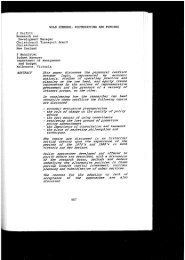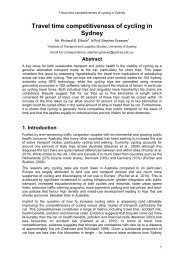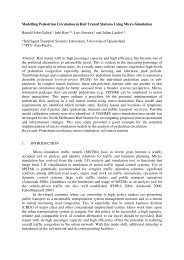PDF: 529 KB - ATRF.info
PDF: 529 KB - ATRF.info
PDF: 529 KB - ATRF.info
Create successful ePaper yourself
Turn your PDF publications into a flip-book with our unique Google optimized e-Paper software.
Explanation ofurban travel increa5e,s<br />
Because the great majority of workers can be assigned a definite workplace, it is<br />
possible, llsing census data, to obtain a fairly precise measure of average<br />
home-workplace separation Using the transportation assignment method, the minimum<br />
airline commuter travel distance can be calculated for each city For Australian cities,<br />
with their job-surplus centres and generally workplace-deficient middle and outer<br />
suburbs, minimum work travel occurs when all workers who cannot be assigned a job in<br />
their own LOA travel to a job located on a ray joining their residence and the city centre<br />
(Hamilton 1982; Moriarty and Beed 1987). Dividing by the relevant workforce then<br />
allows comparison of the average minimum commuter distance for each city, and its<br />
change over time<br />
Unfortunately, the earliest workplace data is for the 1961 census, and is now<br />
available only for Sydney and Melbourne (Sydney Area Transport Study, 1974;<br />
O'Connor and Maher, 1979) From 1961 to 1986, minimum commutes actually<br />
decreased from 5 31rr(l to 4 8km for Melbourne, and from 5.9km to 5.4 km for Sydney<br />
(For comparison, the 1986 values for Adelaide and Perth were 3. 9km and 5..okm<br />
respectively) A possible objection is that workplace specialisation has increased since<br />
1961; allowing for such specialisation would increase the 1986 figures more than the<br />
1961 ones. But job specialisation can have only a minor effect on minimum work trip<br />
distances (Moriarty and Beed, 1988) This conclusion is supported by actual work trip<br />
distances, which appear to have changed very Iitrle over the years; in Melbourne, for<br />
example, it has fluctuated between lOkm and IIkm since 1961<br />
For other home-based trips - and the great majority of urban passenger trips are<br />
home-based - the calculation of minimum separation is more difficult; hence we will only<br />
try to ascertain the direction of change There have been marked changes in educational<br />
training since 1947 Then, the equivalent of about 165% of the Australian population<br />
studied full-time, but by 1986, this figure had risen to 24% (ABS, 1948-52; ABS,<br />
1988) All this increase occured at the secondary and tertiary levels. This rise, combined<br />
with a doubling or trebling of city populations, resulted in a greatly expanded number of<br />
secondary and tertiary educational centres in each city<br />
Overall, for the total student population in each city, the average distance to the<br />
nearest relevant educational institution has probably increased since 1947, because the<br />
catchment areas for secondary and tertiary centres are larger than those for primary<br />
schools. But especially for secondary and tertiary education, average minimum trip<br />
distances will have fallen, because of the increased number of new campuses in the<br />
middle and outer suburbs<br />
Patterns of shopping have also changed greatly Real retail expenditure per urban<br />
resident has doubled between the 1947/8 and 1985/6 surveys of retail establishments<br />
(ABS 1949, 1987) Further, in 1948, the Central mnnicipality in each city (containing<br />
the CBD) averaged over half of each city's retail sales, bnt by 1986 Central sales averaged<br />
only about one-eighth of the total But even in 1948, most food shopping was done in<br />
local shopping centres Today, both central and local shopping centres have lost market<br />
share to the regional drive-in shopping centres<br />
265





